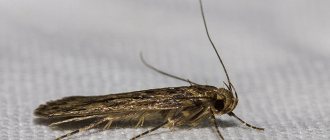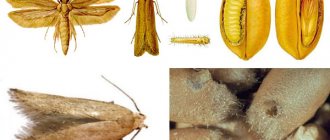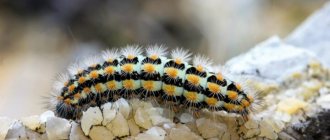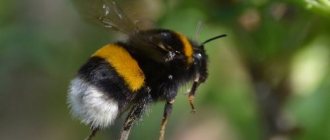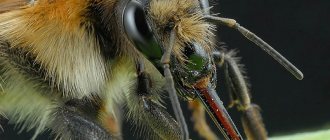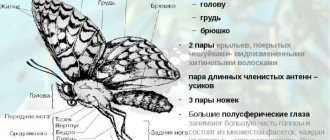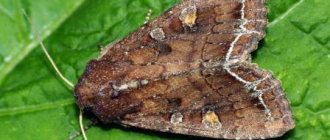Wax moth
Wax moth - bee moth Photo: wax moth - Galleria Mellonella
The large wax moth (Galleria Mellonella), a moth of the moth family (Pyralidae), is evolutionarily adapted to living in a beehive and is known to all beekeepers as a pest. Often the large wax moth is simply called a moth or a bee moth, which is not entirely true, since there are more than 6,000 species in the family of moths (Pyralidae), and in the family of bee moths (Galleriidae), in addition to the large one, there is also a small wax moth, the larvae of which have no medicinal properties . The bee moth is found wherever beekeeping is developed, mainly in the southern regions. Wax moths attack weak bee colonies or waxy raw materials, where they lay eggs, from which caterpillars emerge after 5-10 days. The caterpillars (larvae) of the large wax moth initially feed on beebread, pollen and honey. Then they eat the wax and remnants of the cocoons, and make passages entwined with cobwebs in the honeycombs, thereby damaging the honeycombs and dry land. Large wax moth larvae are the only living creatures that have the unique ability to digest and assimilate beeswax. Wax moth causes great harm to beekeeping.
Activity of moth butterflies in spring
One day early in spring, many moth butterflies appeared in our Moscow apartment. They sat on a variety of places (walls, doors, window sills and window frames). Butterflies from time to time flew from place to place to our “stormy applause,” with which we did not greet the moth at all, but tried to slam it down.
I called the sanitary and epidemiological station and asked what was happening? The employee who answered the phone clearly explained to me that I had to do well in school and know that a moth is just a butterfly. And in the spring the butterflies begin to fly. And not every moth gnaws holes in fabrics or spoils fur coats and food. And it’s not moths who do this, but caterpillars. And then she asked a rhetorical question: “Did you plant poplars under the windows? So what do you want? It was clear from her irritated tone that I was not the first to call that day about the mass appearance of moths. Fortunately, I never encountered so many flying moths again. But a short educational course on the topic of moths turned out to be very useful.
Large and small wax moth
The large wax moth (Galleria Mellonella) and the small wax moth (Achroia Grisella) belong to the family of moths (Pyralidae), currently separated by entomologists into a separate family - wax moths (Galleriidae). Like most moths, large and small wax moths are small moths that are nocturnal and parasitic in bee hives and warehouses of wax raw materials.
Great wax moth (Galleria mellonella)
Females of the great wax moth butterfly have a length of 13-35 mm and a wingspan of 18-32 mm, males are smaller; their length is 9-13 mm, and their wingspan is 17-23 mm. The wings and body of butterflies are covered with scales; when at rest, the wings are folded into a “boat”. The forewings are violet-gray with brown spots in females and yellowish with red-brown spots in males. The hind wings are light gray (with an ash tint) and have dark strokes along the edges. The body of the butterfly (under the wings) is cream-colored. The head is elongated, gray or brown with large faceted eyes and a short proboscis. On the head of females there are long, straight and densely scaly labial palps. The number of males and females has a ratio of 1:1.14, characteristic of solitary insects. The oral and digestive organs of adult wax moths are not developed; they do not feed and live off the nutrients accumulated in the larval stage. The lifespan of females is 5-12 days, males up to 27 days. To lay eggs, females often choose hives with weak bee colonies, which they enter at night and leave before dawn. Females lay eggs in separate batches on the walls of cells with fresh pollen or honey, in the cracks of frames, on the walls or at the bottom of the hive. The eggs are oval in shape, white or light cream in color, smooth, 0.35 -0.5 mm in size. Over the course of her life, a female large wax moth can lay up to 3,000 eggs.
Variety of species
House moths are small insects whose wings are up to 7 mm long and form a triangle when folded. These pests differ in their color to a small extent, since for the most part they are quite inconspicuous and inconspicuous.
If we consider the ermine moth, it will differ not only in its bright color, but also in the way it folds its wings - it is no longer a triangle, but a pyramid. The wallflower also stands out for the colorfulness of its wings, which when folded look like a narrow tube.
Some pests have a unique color that helps them camouflage perfectly. This is necessary mainly for species living in the wild, since they are unable to fly long distances and they also lack any means of protection.
Great wax moth
Male and female Great Wax Moth Picture: Male and female Great Wax Moth (Galleria Mellonella)
Large wax moth larvae.
Lesser wax moth (Achroia grisella)
It is as common as the large wax moth. Females have a length of 7-12 mm and a wingspan of 15-23 mm, the length of males is 4.5-9 mm, their wingspan is 12-17 mm. The forewings of an adult butterfly are narrow, the hind wings are shorter and wider than the forewings. In a calm state, the wings are folded like a roof and slightly overlap each other at the ends. The color varies from ash-gray to dark yellow. On the forehead there is a patch of short yellow hairs. The butterfly's body is flat, its head is lowered. The mouthparts are undeveloped - butterflies do not feed. The number of males and females is approximately the same. The female small wax moth lays eggs in the cracks of the hive, less often in the cells of the honeycomb. The eggs are round or oval in shape, yellow-white in color, 0.2-0.35 mm in size. A female small moth can lay up to 400 eggs. Unlike the larvae of the large wax moth, the larvae of the small wax moth do not have medicinal properties.
Major household and agricultural pests
Particular attention should be paid to what the pest moth looks like. There are few of these species, but they can cause significant damage.
Wax moth
Wax moths are a danger to bee hives. The caterpillars of these insects feed on honey and beebread, and also eat bee larvae. In some cases, large colonies can even destroy insulation, which serves as protection for bees from low temperatures.
Interesting fact! The caterpillars of this type of moth are widely used in medicine, since they, feeding on bee products, perfectly digest wax.
Once in the caterpillar's body, the wax breaks down and, combining with an enzyme, forms a unique substance that destroys pathogenic bacteria. This was the reason why wax moth larvae began to be used as a healing agent for many diseases.
Fur moth
When listing the types of moths, it is impossible to ignore the insect that can destroy your favorite fur coat. For this type of insect, your closet, where fur products are stored, becomes a real “paradise”. After all, it is here that she finds an endless source of nutrition.
Fur moth caterpillars carefully trim the fibers using their mouthparts, then crush them and swallow them. After saturation, the larva moves towards its nest and “along the way” cuts off the fur hairs that prevent it from moving freely. That is, these individuals parasitize not only for saturation. As a result, narrow tracks of cut pile are formed on the fur product.
Clothes moth
Clothes moths mainly destroy wool products. External features include the straw color and small size of the insect, which reaches 9 mm with folded wings.
Attention! In addition to items made from natural fabrics, clothes moths can also damage semi-synthetic materials. But with such nutrition, the development process of the caterpillar slows down and it reaches the stage of puberty somewhat later.
Females always move on foot, since, despite the presence of wings, they have no need to fly. During the breeding season, males find them on their own, after which females lay eggs without moving long distances.
Indoor (furniture) moth
The furniture moth is an inconspicuous butterfly of a light yellow hue. Its wings have a characteristic golden tint. Over the course of 15 days, the female lays eggs, the number of which can reach 300 pieces.
While in the caterpillar stage, indoor moths are inactive. They begin to move only after they begin to eat fully. The larvae are very afraid of bright light, and if you put something infected with these pests in the sun, you can see how they begin to hide in folds or crawl into their cocoons.
Important! A decrease in air temperature in the zone of their parasitism can stop the development of caterpillars. They hide in their cocoons and stop parasitizing.
Potato moth
When listing the types of moths, it is worth paying attention to parasites that can cause harm to agricultural land. These individuals include the potato moth. Its appearance is rather unattractive - the wings are a dirty gray color with numerous dark spots.
Fledged individuals have long antennae and live only a few days. When the wings are folded, the body length reaches about 7 mm. The inconspicuous color allows the butterfly to remain invisible even at a short distance when viewed directly.
The caterpillars of this species are distinguished by a light green color; sometimes pale pink larvae are found. The female lays eggs on the underside of the plant leaf, from which, after a short period of time, larvae emerge and begin to develop very quickly.
Attention! The caterpillars die when the temperature drops to +4°C, but having settled directly in the tubers, they can remain alive. As a rule, when cold weather sets in, they move into barns, where they feed on seed potatoes, after which they enter the ground during planting in the spring.
Cabbage moth
Cabbage moth is a pest of cruciferous plants. It has an elongated body and light brown wings. When the wings are folded, the butterfly looks like a small straw. There is a fringe along the edges of the wings of an adult. Like many other species, the cabbage pest flies rather poorly and always remains in close proximity to the place where it emerges from the cocoon.
The caterpillar's head is brown. These insects rarely accumulate in numerous colonies - as a rule, one or two individuals parasitize on one leaf. In the pupal stage, this pest can be found on the stems and leaves of plants, which they feed on.
The eggs of this parasite are easily recognized by their small size and elongated shape. The egg length can reach 0.44 mm, width - 0.26 mm, color - green, which makes them invisible against the background of foliage.
food moth
Food or granary moths can be found in products that were stored in violation of basic rules. Most often these are groceries and cereals. In nature, the source of food for this type of insect is the nuts and fruits of many plants, which causes the parasites to be frequently found in the forest-steppe and steppe zones.
Interesting fact! Food moths are not capable of causing harm to clothing and furniture, since they feed exclusively on cereals, flour, sugar, dried fruits and berries, and can also parasitize in dry pet food.
When the wings of an adult are folded, its body length reaches 8 mm. A moth sitting on any surface is quite difficult to notice at first glance, since it looks more like a small protrusion than an insect.
Caterpillars of this species are light yellow or light pink in color with a smooth body surface. It is impossible to determine the type of barn moth by the appearance of the larvae, but one thing saves you - the fight can be carried out using the same means, so the species is not important.
Normal development of this species occurs under certain conditions:
- air temperature up to +25°C;
- air humidity is about 50%.
The life cycle of a food moth is about one and a half months. This time period includes all stages of insect development.
Chestnut moth
The chestnut moth parasitizes the leaves of horse chestnut and maple trees. They spend the winter in the pupal stage, and with the onset of spring, adult individuals emerge from the fallen leaves, are fertilized, and after 2-3 weeks, offspring appear and adhere to the blossoming leaves.
The parasites leave behind raised orange spots located over the entire surface of the leaf.
Preventing the occurrence of moths is the most powerful argument that will keep your property and garden plot intact and will not force you to throw away food. But if this parasite has already settled near you, then you must immediately choose an effective remedy to combat it.
The modern market is replete with a variety of insecticides for these pests, but it is worth remembering that some species are able to quickly develop immunity and continue to reproduce intensively.
Lesser wax moth
Lesser wax moth male and female Picture: male and female Lesser wax moth (Achroia grisella)
Small wax moth larvae.
Beekeepers often confuse large and small wax moths, since the size and color of the moths are variable and depend on the qualitative composition of the honeycombs on which the insects feed in the larval stage and the temperature at which they develop.
Prevention
It is always easier to prevent moths from appearing than to fight them, so you must adhere to the following rules:
- Before bringing food, items or old furniture into your home, carefully check them for the presence of larvae and adult moths.
- If you find contaminated food, throw it away.
- Wash items from second-hand stores at 60°C;
- Ventilate your kitchen cabinets periodically. If you have an ultraviolet lamp, it can be used instead of sunlight.
- Place a clove of garlic in the container with cereal.
- Have geraniums in your house.
- Place anti-moth tablets in the cabinets.
Use aromatic oils in cabinets and cabinets with food, which not only repel moths , but also smell pleasant. Compliance with the described rules and recommendations will help protect the house from the appearance of moths, and if this dangerous pest penetrates it, then effectively fight it.
Medicinal properties of wax moth larvae
Recently, articles have appeared on the Internet claiming that wax moth products are a placebo, since there is no scientific justification or evidence of their effectiveness. Articles with such statements were written by incompetent people or out of ignorance (for example, on Wikipedia), or for the purpose of promotion in search engine results (for example, on a group of affiliated satellite sites about the control of domestic insects) and have nothing to do with real information about scientific research on medicinal products made from wax moth larvae do not have the properties and effectiveness of use.
The healing properties of wax moth larvae were known in ancient Asian countries and Egypt. In Russian folk medicine, from ancient times they were used to prepare remedies for the treatment of age-related changes and tuberculosis.
The first scientific studies of wax moth larvae date back to the end of the 19th century. The Russian scientist Nobel Prize winner I. I. Mechnikov drew attention to the ability of a folk remedy to cure tuberculosis. It was Mechnikov who first suggested that the larvae of bee moths (Galleria mellonella) may contain substances capable of lysing (destroying) the waxy membranes of tuberculosis bacteria.
Reasons for appearance
To effectively combat moths, you need to find the source and reasons for its entry into the apartment .
The main reasons for the appearance of moths:
- Flew in through an open window on its own. If there is no protective net on it, then this insect can fly into the house and take root in it. Using a mosquito net will eliminate such troubles.
- Brought into the house along with things. These could be woolen or knitted clothes that you took from your grandmother. It is not necessary that these are adult pests: their larvae, which are difficult to notice, are sufficient. To prevent this from happening, things should be well ventilated and left in the sun for several hours before bringing them into the house.
- Came with old furniture. The larvae can be found in the upholstery of old sofas. They look like small white cocoons. Almost all old furniture is contaminated, so if there is a need to bring it into the house, you must first treat the fabric with special means.
- Introduced by domestic animals . Larvae may be on their fur, so you should periodically wash the animals with special shampoos that help get rid of any parasites.
- It came with cereals that were improperly stored in a warehouse, or with dried fruits and mushrooms purchased at the market.
Most often, moths enter an apartment along with new things that contain fur and wool.
Mechnikov I. I.
Mechnikov Ilya Ilyich (1845-1916) Photo: Mechnikov I. I. - the first researcher of the medicinal properties of wax moth
Mechnikov Ilya Ilyich (1845-1916) - Russian scientist Nobel laureate in physiology and medicine in 1908 “For his work on immunity.” Among I. I. Mechnikov’s numerous awards is the Copley Medal of the Royal Society of London, an honorary doctorate from the University of Cambridge, and he is also a member of the French Academy of Medicine, an honorary member of the St. Petersburg Academy of Sciences and Moscow University, and a member of the Swedish Medical Society. Mechnikov is one of the founders of evolutionary embryology, the discoverer of phagocytosis and intracellular digestion, the creator of the phagocytic theory of immunity, and the founder of scientific gerontology. Since 1887, head of the laboratory at the Pasteur Institute in Paris.
Mechnikov’s idea about the ability of wax moth larvae to destroy the membranes of tuberculosis bacteria formed the basis for a large series of studies by the Russian immunologist Professor S.I. Metalnikov. Metalnikov experimentally proved and substantiated that the high immunity of wax moth larvae to a number of microorganisms pathogenic for humans (causative agents of tuberculosis, diphtheria, tetanus, plague, etc.) is due to a specific enzyme - cerase, which breaks down wax.
Preventive actions
Preventive measures to protect food supplies from pests:
- Use of traps. They are sold in specialized stores or through a network of online stores. Odorless traps are especially suitable. These are produced by TM Raptor. They are made of cardboard with a layer of very sticky glue and pheromones. They are glued to the wall of the cabinet. The trap protects against pests for 90 days.
- Moderation in purchasing. Experienced housewives do not make large stocks, but buy fresh cereals every time. It is also important to check the expiration date. If the cereal has been stored in a warehouse for a long time, it may have nests of parasites. After purchasing a new portion of cereal, it is advisable to first warm it up or freeze it. Some people also decide to store grains in the freezer.
- Cleanliness and tidiness. It is advisable to thoroughly clean all cabinets every month. It is also useful to regularly ventilate the kitchen. Fluttering insects do not like fresh air and drafts.
- The pest can choose a secluded place under baseboards or on carpets, so it is important to thoroughly vacuum all crevices and darkened areas. And the larvae can colonize ceiling lamps and corners of window frames, so they should also be washed thoroughly.
- Ultraviolet irradiation helps get rid of harmful insects. Sunlight kills pests in just 60 minutes. Temperatures that are too high or low are lethal to the larvae. Moth eggs die at low temperatures within 24 hours. Things need to be dried and beaten out periodically.
The appearance of any type of moth is always very upsetting for owners. The fight against it will be effective if preventive measures are followed constantly, and not used as a one-time event.
If the housewife constantly monitors and checks the contents of the lockers, then she is guaranteed cleanliness and order.
Metalnikov S. I.
Metalnikov Sergey Ivanovich (1870-1946) Photo: Metalnikov S.I. - author of the name of the digestive enzyme of wax moth larvae: cerase
Metalnikov Sergei Ivanovich (1870-1946) - Russian scientist: biologist, zoologist, immunologist. Published more than 250 scientific papers in the field of comparative physiology of invertebrates, applied microbiology and immunology in Russian and Western European languages. Some of Metalnikov's works opened up new areas of research. In 1907–1908 worked in the laboratory of I. I. Mechnikov at the Pasteur Institute in Paris. Since 1919, he has been a permanent employee of the Pasteur Institute, where he studied the immunity of invertebrates (primarily insects) and the connection between immunity and the activity of the nervous system. The founder of psychoneuroimmunology, a new field of medicine. Author of the famous book “The Problem of Immortality and Rejuvenation in Modern Biology” (1924), dedicated to the phenomenon of aging of the body.
You can find many publications on the Internet, including on Wikipedia, in which the existence of the cerase enzyme is questioned and all authors of scientific papers on the medicinal properties of wax (bee) moth larvae are called “persons not known in either medical or biological circles.” " If the authors of such publications do not know the names of Mechnikov, Metalnikov and other scientists, as well as numerous publications (list of published scientific articles) in authoritative scientific publications, then a logical question arises - what relation do such authors have to medical and biological circles?
In addition to Metalnikov (the author of a large series of publications on the immunity of wax moth larvae: Metalnikov, 1906, 1907, 1908, 1915, 1921; Metalnikov, 1907, 1908, 1920, 1921, 1935) an enzyme preparation that has a destructive effect on tuberculosis bacteria and has high lipolytic activity in relation to the lipids of Mycobacterium tuberculosis (Koch's bacillus), Mankiewicz E. was isolated from the larvae of the great wax moth (Mankiewicz, 1949; 1952). The antimicrobial effect of wax moth larvae extract against Mycobacterium tuberculosis was also confirmed in the works of other authors (Olivier, 1947; Kuzniecow and Wojciechowski, 1950; Paszewski, 1959).
A large series of studies of the cerase enzyme was carried out by the Bosnian biochemist MK Muftic (Mahmud Kamal Muftic) at the Tuberculosis Research Institute (Borstel Center) in Schleswig-Holstein (Germany) and the Biochemical Laboratory at the University of Lausanne (Switzerland). Scientific work of MK Muftic on the study of the enzyme cerase and its activity against Mycobacterium tuberculosis in the period 1955-1970. published in authoritative scientific journals around the world (British Journal of Tuberculosis, Enzymologia, Tubercle, Indian Journal of Medical Sciences, Pathologia and Microbiologia, The Japanese journal of tuberculosis, etc.).
Sense organs
Only mosquitoes and honey bees can boast of this type of receptor, developed to a unique state with a huge number of possibilities. But nature has not endowed moths with such a wide range of advantages.
The “fluff” on the body of the caterpillars provides the larva with a sense of touch. Insects sense touch very well using long tactile hairs that grow over almost the entire surface of their exoskeleton and are connected to nerve cells that transmit contact information to the insects' brain.
Sensory hairs on the body of adult individuals are located throughout the body, especially on the antennae. In addition to tactile and “culinary” sensitivity, they provide information about the speed and direction of the wind while the insect is in flight.
MK Muftic
Mahmud Kamal Muftic (1925-1975) Photo: MK Muftic – author of scientific works on the digestive enzyme of wax moth larvae
Mahmud Kamal Muftic (MK Muftic 1925-1975) - Bosnian biochemist, published about 40 articles on bacteriology (including tuberculosis) in medical journals around the world. He is a co-author of several patents owned by the German pharmaceutical company Schering AG (now Bayer AG). From the end of 1940 to the beginning of 1960, MK Muftic worked as a doctor and researcher in several countries of the Middle East (Egypt, Iran, Saudi Arabia). Since 1962 worked at the Tuberculosis Research Institute in Schleswig-Holstein, West Germany. Since the late 1960s, he has been employed in the biochemistry laboratory at the University of Lausanne in Switzerland and collaborated with the biochemistry department at Trinity College Dublin.
Modern studies of wax moth larvae extract, conducted at the Institute of Cell Biophysics of the Russian Academy of Sciences, confirm the existence in the high-molecular fraction of acidic serine protease (cerase enzyme), capable of dissolving cell membranes. According to researchers from the Institute of Cell Biophysics of the Russian Academy of Sciences, it is the proteolytic enzyme, serine protease, that plays a leading role in the resorption of blood clots and plaques in blood vessels and lung tissue, as well as in the regeneration of scar tissue after a heart attack.
A major contribution to the study of the medicinal properties of wax moth belongs to the Moscow cardiologist and homeopath S. A. Mukhin. Even in his youth, a folk remedy made from wax moth larvae helped him cope with his own illness - tuberculosis. In his works devoted to the treatment of cardiovascular diseases, S. A. Mukhin was able to scientifically substantiate and prove the prospects of using wax moth larvae extract in the treatment of atherosclerosis, cardiosclerosis, angina pectoris and myocardial infarction, as well as tuberculosis and senile diseases.
Navigation
Moths never simply move anywhere, as many of our readers may believe. Actually, like no other living organism, with the exception of humans. Everything in the animal and plant world is interconnected, and cannot happen just like that, out of nothing to do. In particular, moths always fly either in search of a mate or food, or for the purpose of laying eggs.
There is a lot of debate today about why moths are so attracted to light, but in fact, this information remains a mystery. One of the hypotheses, which can also explain why butterflies are more active in the light, says that the heat of the light warms up the muscles of the moth’s wings, since moonlight does not warm at night. However, this idea has not yet been scientifically proven. Another, also quite well-known theory is that light, in particular its ultraviolet part, emits energy similar to that given off by night flowers, the nectar of which is the main food for insects.
The course and speed of the moth's flight are determined by the moon and stars, and when these are not available, the insect is guided by geomagnetic clues from the earth.
Other interesting information
- Adult clothes moths and kitchen moths, which are well known as household pests, do not feed at all. The main harm they cause to humans comes from the larvae, which have extremely high gluttony. People often ask: where do moths come from? The answer is very simple - it flies in from the street.
- The science that studies moths and butterflies is known as lepideroptology, and biologists who specialize in this discipline are called lepidopterists.
- Often moths are pests. Various species, especially in the larval stage, are major agricultural and household pests in many parts of the world. The gypsy moth caterpillar, for example, causes severe damage to forests. In temperate climates, the codling moth causes significant damage to fruit production. In tropical and subtropical climates, the cabbage moth is perhaps the most serious pest of cruciferous crops - the mustard and cabbage families. Read more about cabbage moth.
- Insects are able to “hear” sounds through their wings, thanks to the vibration of pollen on them.
- Many species of moths and butterflies have a well-developed special organ, called Johnston's organ, located at the base of the antennae. This organ is responsible for maintaining a sense of balance and orientation during flight.
Mukhin S. A.
Mukhin Sergey Alekseevich (1905-1981) Photo: Mukhin S.A. - scientifically proved the effectiveness of wax moth extract in the treatment of cardiovascular diseases
Mukhin Sergey Alekseevich (1905-1981) – Russian scientist: homeopath, cardiologist. One of the founders of the Moscow homeopathic school. Since 1934, he worked at the Institute of Cardiology on his dissertation and was the best student of Professor D. D. Pletnev. Co-author of uniquely important works on atherosclerosis. Throughout his life, Mukhin studied ancient manuscripts of traditional medicine, which formed the basis of later pharmacology. Being a famous homeopath, Mukhin fought against the unfair persecution of homeopathy by official Soviet medicine. It is precisely because of the non-acceptance of homeopathic methods of treatment by official Soviet science that very little is known about the multifaceted research and achievements of S. A. Mukhin.
The amazing ability of wax moth larvae extract to restore tissue after deep morphological damage (to resolve fresh scars after a myocardial infarction, as well as to heal tuberculous cavities in the lungs and replace them with healthy tissue) was proven in the 1980s by Professor M. N. Kondrashova at the Institute of Biological Physics AH CCCP.
General composition of wax moth extract/tincture
Thanks to the unique diet of large wax moth larvae, which includes substrates rich in biologically active substances (breadbread, honey and beeswax containing propolis, as well as bee waste products: royal jelly, bee and drone brood), LVM extract has a complex and balanced chemical compound.
| Chemical compound | Content of wax moth larvae in the extract (% dry matter) |
| High molecular weight substances | 2 |
| Nucleotides and nucleosides | 1,5 |
| Free amino acids | 50-60 |
| Monosaccharides and disaccharides | 2-4,7 |
| Fatty acid | 0,1 |
| Minerals | 7,1-9,1 |
Full chemical composition of wax moth larvae extract.
Wax moth larvae extract contains a large amount of free amino acids, monosaccharides and disaccharides, nucleotide bases and their derivatives, fatty acids, biologically important elements and trace elements (potassium K, phosphorus P, copper Cu, manganese Mn, selenium Se, chromium Cr, molybdenum Mo, magnesium Mg, cobalt Co, calcium Ca, zinc Zn, iron Fe, etc.). The high molecular weight fraction of the extract contains acidic serine protease (cerase enzyme) and aromatic compounds associated with sugars and amino acids. The extract of wax moth larvae contains biologically active substances that stimulate the contractile activity of smooth muscles and accelerate the growth of cells and tissues.
Usually, when describing the valuable components of propolis, royal jelly or drone jelly, decenoic acids are especially emphasized. But few people know that the extract of wax moth larvae also contains decenoic acids , namely: oleic (cis-9-octadecenoic acid) and palmitoleic (cis-9-hexadecenoic acid) acids.
Decenoic acids are unsaturated fatty acids, found only in the body of bees and humans, secreted by the glands of bees and have no analogues in nature. Decenoic acids have high biological activity, an antiviral effect at the cellular level and a powerful anti-inflammatory effect. Decenoic acids are effective against the toxoplasma virus in the cells of the nervous system and liver, thereby helping to stabilize and regulate the nervous system and restore liver function.
Everything described above refers to a real extract (tincture) made from freshly collected wax moth larvae grown on natural food - dark waxy sushi with the remains of bees.
In the last few years, products have appeared on sale that are allegedly made from wax moth larvae, but in reality are not such. Some of these products are just pacifiers - placebos, and some are really dangerous to health. You can learn about how not to buy a fake or dummy instead of a real product made from wax moth larvae, why wax moth extract cannot be bought in a pharmacy, how the extract differs from a tincture, as well as about us and our experience, from the article “Wax moth - where to buy ?.
How to get rid of moths in an apartment
There are many options for exterminating lepidopteran pests and disinfecting your home. All methods are divided into two categories:
- Chemical.
- Folk.
The use of special toxic drugs and toxic compounds that are safe for humans, but poisonous for keratophages, allows us to solve the problem radically and in the shortest possible time. Folk remedies involve the use of natural biological substances and a variety of unconventional techniques, tested by generations of housewives.
Destruction of moths with chemicals
Fumigators are popular. These are special electrical appliances that are plugged into an outlet. When heated, they release a toxic gaseous substance that is lethal to flying insects, but harmless to humans. Another common means of combating keratophages is aerosols and sprays. They destroy both adults and larvae.
The drug is sprayed in the room where it is necessary to disinfect. Clothes, furniture, building structures and interior parts are subjected to chemical treatment. The active compound acts instantly and is deadly effective. There are also special traps equipped with adhesive tape. They secrete female pheromones that attract males.
Folk remedies for moth control
The advantages of such methods are:
- high efficiency;
- complete safety for human health;
- wide availability;
- minimal financial costs.
Lepidopteran insects react nervously to the cedar aroma. By placing twigs and pieces of bark of this tree in infected areas, you can get rid of moths in the shortest possible time. Essential oil with a cedar aroma has a similar effect on pests. A simple and accessible way for every housewife to kill moths is to use laundry soap.
They lubricate cabinet shelves, pantry surfaces, and clothes. It is not advisable to use against kitchen varieties of parasites. Products may absorb strong and unpleasant odors. Naphthalene has been known for centuries, but it does not lose its relevance. The substance contains potent carcinogens. Therefore, it is not recommended to use against food keratophages.
Moths are a dangerous pest that causes a lot of trouble for people. Preventive measures and proposed means of exterminating insects will help protect your own home, garden plot, and subsidiary plot. At the first signs of the appearance of a parasite, it is recommended to carry out thorough disinfection in order to avoid the serious consequences of its activity.
Application of extract and tincture of wax moth larvae
The list of diseases for which the extract/tincture of wax moth larvae is effective is constantly growing, as research into the medicinal properties of the larvae is being conducted by scientists from different countries. To date, the effectiveness of using LVM extract for the following diseases has been scientifically substantiated and clinically proven:
- tuberculosis of the lungs and other organs (tuberculosis of the lymphatic and digestive system, tuberculosis of bones and joints, tuberculosis of the genitourinary organs, skin, eyes, tuberculosis of the central nervous system, tuberculosis of the meninges, etc.);
- diseases of the cardiovascular system (atherosclerosis, myocardial infarction, coronary heart disease, angina pectoris, cardiosclerosis, cardiac arrhythmias, hypertension, myocarditis of various etiologies, vegetative-vascular dystonia, varicose veins and other diseases of the cardiovascular system);
- bronchopulmonary diseases (bronchitis, pneumonia, pleurisy, bronchial asthma, fungal diseases of the lungs, etc.);
- gynecological diseases (infertility, toxicosis of the first half of pregnancy, disorders of the structure of endometrial cells, anemia, menopausal disorders, placental insufficiency, etc.);
- andrological diseases (prostate adenoma, low sperm motility, male infertility, impotence, decreased libido, low testosterone levels, etc.);
- during the recovery period after operations and injuries (after extensive inflammatory processes, suppuration and surgical interventions);
- as a general strengthening agent that enhances immunity (extract/tincture of wax moth larvae is a powerful natural immunostimulant).
Read more about treatment with wax moth larvae extract in the section “Wax moth - treatment”.
It is worth especially noting that, despite its high efficiency, the extract/tincture of wax moth larvae has no side effects or contraindications, with the exception of individual intolerance. Also, taking the extract is compatible with most pharmacological drugs, including anti-tuberculosis antibiotics.
Take LVM extract/tincture drops (the number of drops depends on the disease, weight and age) dissolved in water (50-100 ml) 30-40 minutes before meals 2-3 times a day. The minimum course of admission is 3 months. For children 5-14 years old, courses last 21 days, then a break of 21 days. For adults 3 months daily.
You can learn more about the methods of using extract/tincture of wax moth larvae for various diseases, as well as calculate an individual dosage regimen online (depending on your disease, weight and age) using an interactive calculator in the “Wax moth - application” section.
Interesting Facts
Some species have a very long proboscis, or tongue as it is sometimes called, which insects use to suck out nectar or other plant fluids. This proboscis tends to roll up very tightly when there is no need to use it. But while the insect is feeding, the tongue “unwinds” to its entire length, and in some species, in the unfolded state, it can be several times longer than the body.
For example, the Madagascar hawk moth, which is a direct relative of the well-known poplar hawk moth, which we talked about in detail in this article, has a proboscis about 33 cm in length. This unique feature was certainly acquired by the insect in the process of evolution, since its main diet is the nectar of orchids growing in this region, the flowers of which have a very deep “neck”.
However, not all types of moths have such “long tongues”. Many of them have a very short proboscis, and this is also a consequence of evolution, since such an adaptation allows them to easily and efficiently feed on fruit juice.
The remaining species, of which there are many more, do not have a mouthparts at all. More precisely, it exists, but its components are so reduced that there is absolutely no way to use them. It, apparently, is not necessary, since adult individuals throughout their, as a rule, very short life, can waste the energy that they have accumulated while at the stage of a very voracious larva, which is better known to us under the definition of a caterpillar.
Antennae, or, to be more correct, antennae, as well as limbs and many other parts of the body, are literally studded with sensitive receptors that the insect uses to evaluate the environment and search for food. This kind of sense of smell is used mainly for searching for flower nectar and finding a mate for procreation.
Among almost all species of these insects, females fly to meet males, who release their odorous pheromones into the air. These aromatic substances are produced on the last segment of the middle pair of limbs, by scales on the wings or by glands located on the abdominal region. It is worth noting that the female of our ordinary clothes moth is capable of detecting a male at a distance of more than 2 km, provided there is a fair wind, although, of course, she will not be able to fly to him.
Answers to questions about wax moths and LVM products
Can wax moth tincture be used in the treatment of stroke and from what day?
“LVM extract is used to treat the consequences of strokes; use can be started from 14-21 days.”
Read more…
Will wax moth extract help in the treatment of varicose veins?
“LVM tincture/extract helps with varicose veins, has an antioxidant and strengthening effect, promotes healthy coronary microcirculation, prevents the formation of blood clots, reduces thrombus formation.”
Read more…
I was seriously ill with tuberculosis, now I have recovered, in what quantity should I take 10% wax larvae extract...
“In your case, you only need prevention.
Take 10% extract 20-25 drops dissolved in 50-100 ml of water 2-3 times a day 30-40 minutes before meals.” Read more…
My son and I, as contacts of patients with bacillary tuberculosis, were prescribed preventive treatment with isoniazid. Of course not...
“Yes, such cases do happen; it was enough for everyone to take LVM extract without isoniazid (even with changes in the tuberculin test).”
Read more…
If I took wax moth tincture for a year to prevent tuberculosis, I never had it...
“If you communicate with people with tuberculosis or you have had a turn, then for prevention you should continue to take wax moth tincture (2 times a year in courses of 3 months).
The substances contained in the tincture/extract of LVM have a cumulative effect and are eliminated from the body over time.” Read more…
I have diabetes and other health problems have arisen due to the disease. Does wax moth tincture reduce...
“The extract/tincture of wax moth larvae reduces the sugar level - this is reliably known from correspondence and personal contacts with our customers.
Wax moth larvae tincture/extract contains 6.2 – 10.7% of the essential amino acid alanine (aminopropanoic acid). Alanine is an important source of energy for the brain and central nervous system; strengthens the immune system by..." Read more...
Will wax moth extract help with resistant tuberculosis?
“Treatment of tuberculosis is a complex and lengthy process and, as a rule, wax moth larvae extract alone cannot be used.
Treatment should be carried out under the supervision of a doctor step by step and comprehensively with several anti-tuberculosis and immune-stimulating drugs. It is optimal to take a course of taking the extract (3 months) before a course of chemotherapy, however, in almost all (95%) known to us for..." More details...
I would like to clarify with you how many vials I need to order to treat tuberculoma. My aunt taught one course...
“To treat tuberculoma, you need to take at least 2-3 month courses with a break between courses of 3-4 weeks.
You can calculate what you need using an online calculator, which allows you to calculate the number of bottles of tincture/extract of wax moth larvae required for treatment and an individual dosage regimen depending on weight and disease. From the list of diseases, select “treatment...” Read more...
Can wax moth tincture be used for liver disease?
“The tincture/extract of LVM can be taken for liver diseases, it is even recommended to take it after courses of various drug treatments, since it contains essential amino acids: aspartic acid - helps the liver remove residual products of drugs and chemicals from the body;
threonine - improves lipotropic function and liver activity, prevents the deposition of fats in it; methionine..." Read more...
What plants are threatened by insects?
To begin the fight against a harmful parasite, you need to find out the type of attacking moth.
| Variety | What crops does it affect? | Signs of defeat |
| Potato. | Potatoes, peppers, tomato, eggplant, tobacco. | Plants take on an anemic appearance, the foliage becomes covered with a thin cobweb. |
| Onion. | Onion garlic. | The leaves of the crop turn yellow and dry out, and the plant quickly dies. |
| Cabbage. | Cabbage, rutabaga, rapeseed, radish, mustard, radish, turnip. | The affected vegetable shrivels, the fruits begin to rot, the buds are eaten away, and holes appear on the leaves. |
| Tomato (mining). | All types of tomatoes. | Withering of plants, death and rotting of fruits. |
| Apple (ermine). | Fruit trees. | They eat the leaf mass, the leaves turn yellow, dry out, and can destroy up to 80% of the fruit harvest. |
| Grape (circle). | Vine plantings. | Oily patches appear on the foliage, and the vine gradually dries out and dies. |
| Wax (fire). | Bee hives. | Cobwebs appear on the bodies of bees, and their flight slows down. |
| Poplar. | Almost all green spaces and fruit trees. | The appearance of eaten away cavities on the foliage, the leaves acquire a mosaic color. |
| Rowan (variegated). | Rowan, apple trees. | Dark spots on the fruits, perforated leaves. |
| Bud (currant). | Raspberries, currants, blackberries. | The bushes become as if burned or frostbitten, the leaves wither and curl. |
There are species of moths that suck the tears of sleeping animals. The large Madagascar moth is famous for this.
